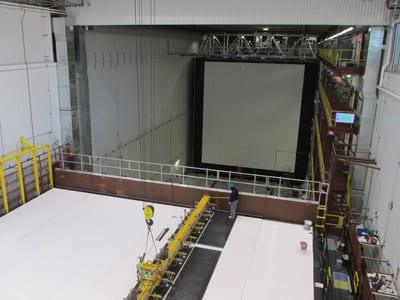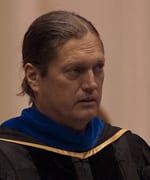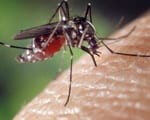Ghostly particles that constantly bombard us can offer clues to the early moments of our universe
Scientists hunting one of nature’s most elusive, yet abundant, elementary particles announced today they’ve succeeded in their first efforts to glimpse neutrinos using a detector in Minnesota.
Neutrinos are generated in nature through the decay of radioactive elements and from high-energy collisions between fundamental particles, such as in the Big Bang that ignited the universe.
Light and ghostly, however, they are unaffected by magnetic fields and travel at the speed of light.
The neutrinos that currently bombard the earth from space are mostly produced by the nuclear reactions that power our sun.
More than 200 physicists from around the world collaborate on the massive neutrino experiment called NOvA, which has taken a decade to design and build.
Their goal is to discover more details about neutrinos, which were theorized in 1930 and first observed in 1956.

“These first few neutrino events are a confirmation that NOvA’s basic detector design and construction that dozens of people have worked on for a good fraction of a decade are sound,” said Thomas E. Coan, an associate professor in the SMU Department of Physics, who is a researcher in the NOvA collaboration.
Studying neutrinos could yield crucial information about the early moments of the universe, Coan said.
“Neutrinos are fascinating. They are, besides light, the most numerous particle in the universe yet are notoriously difficult to study since they interact with the rest of matter so feebly,” he said. “Produced in many venues, from laboratories to stars and even bones, they may be their own anti-particles and perhaps play a key role in explaining why any matter at all exists today and survived annihilation with its sister anti-matter produced all the way back in the Big Bang, many billions of years ago.”
NOvA is the world’s longest-distance neutrino experiment
The NUMI Off-Axis electron neutrino Appearance, or NOvA, is the world’s longest-distance neutrino experiment. It consists of two huge particle detectors placed 500 miles apart, and its job is to explore the properties of an intense beam of neutrinos.
“NOvA represents a new generation of neutrino experiments,” said Fermilab Director Nigel Lockyer. “We are proud to reach this important milestone on our way to learning more about these fundamental particles.”
Scientists generate a beam of the particles for the NOvA experiment using one of the world’s largest accelerators, located at the Department of Energy’s Fermi National Accelerator Laboratory near Chicago. They aim this beam in the direction of the two particle detectors, one near the source at Fermilab and the other in Ash River, Minn., near the Canadian border. The detector in Ash River is operated by the University of Minnesota under a cooperative agreement with the Department of Energy’s Office of Science.
Billions of those particles are sent through the earth every two seconds, aimed at the massive detectors. Once the experiment is fully operational, scientists will catch a precious few each day.
“It is both intellectually and emotionally satisfying,” said SMU’s Coan, “akin to a great adventure, to be detecting neutrinos in Northern Minnesota that are produced some 500 miles to the south at Fermi National Laboratory near Chicago, after making thousands of engineering and scientific decisions that had to be spot-on to see these events.”
Scientists will use NOvA to understand three changing flavors of neutrinos
Neutrinos are curious particles. They come in three types, called flavors, and change between them as they travel. The two detectors of the NOvA experiment are placed so far apart to give the neutrinos the time to oscillate from one flavor to another while traveling at nearly the speed of light. Even though only a fraction of the experiment’s larger detector, called the far detector, is fully built, filled with scintillator and wired with electronics at this point, the experiment has already used it to record signals from its first neutrinos.
“That the first neutrinos have been detected even before the NOvA far detector installation is complete is a real tribute to everyone involved,” said University of Minnesota physicist Marvin Marshak, Ash River Laboratory director. “This early result suggests that the NOvA collaboration will make important contributions to our knowledge of these particles in the not so distant future.”
Once completed, NOvA’s near and far detectors will weigh 300 and 14,000 tons, respectively. Crews will put into place the last module of the far detector early this spring and will finish outfitting both detectors with electronics in the summer.
The NOvA collaboration is made up of 208 scientists from 38 institutions in the United States, Brazil, the Czech Republic, Greece, India, Russia and the United Kingdom. The experiment receives funding from the U.S. Department of Energy, the National Science Foundation and other funding agencies.
The NOvA experiment is scheduled to run for six years. Because neutrinos interact with matter so rarely, scientists expect to catch just about 5,000 neutrinos or antineutrinos during that time. Scientists can study the timing, direction and energy of the particles that interact in their detectors to determine whether they came from Fermilab or elsewhere.
“Seeing neutrinos in the first modules of the detector in Minnesota is a major milestone”
Fermilab creates a beam of neutrinos by smashing protons into a graphite target, which releases a variety of particles. Scientists use magnets to steer the charged particles that emerge from the energy of the collision into a beam. Some of those particles decay into neutrinos, and the scientists filter the non-neutrinos from the beam.
Fermilab started sending a beam of neutrinos through the detectors in September, after 16 months of work by about 300 people to upgrade the lab’s accelerator complex.
Different types of neutrinos have different masses, but scientists do not know how these masses compare to one another. A goal of the NOvA experiment is to determine the order of the neutrino masses, known as the mass hierarchy, which will help scientists narrow their list of possible theories about how neutrinos work.
“Seeing neutrinos in the first modules of the detector in Minnesota is a major milestone,” said Fermilab physicist Rick Tesarek, deputy project leader for NOvA. “Now we can start doing physics.” — Andre Salles, Fermilab, and Margaret Allen, SMU
Follow SMUResearch.com on Twitter.
For more information, www.smuresearch.com.
SMU is a nationally ranked private university in Dallas founded 100 years ago. Today, SMU enrolls nearly 11,000 students who benefit from the academic opportunities and international reach of seven degree-granting schools. For more information see www.smu.edu.
SMU has an uplink facility located on campus for live TV, radio, or online interviews. To speak with an SMU expert or book an SMU guest in the studio, call SMU News & Communications at 214-768-7650.


 Wall Street’s short sellers wrongly maligned — detected red flags ahead of US financial crisis
Wall Street’s short sellers wrongly maligned — detected red flags ahead of US financial crisis A director’s skills, experiences and workload drive their compensation, SMU study finds
A director’s skills, experiences and workload drive their compensation, SMU study finds Gut reaction of marital partners could foretell their marriage satisfaction
Gut reaction of marital partners could foretell their marriage satisfaction Fossil supervolcano discovered in Italy by SMU-led team is now key feature of new UNESCO Geopark
Fossil supervolcano discovered in Italy by SMU-led team is now key feature of new UNESCO Geopark NPR: “Boiling Hot: How Fracking’s Gusher of Geothermal Energy is Wasted”
NPR: “Boiling Hot: How Fracking’s Gusher of Geothermal Energy is Wasted” KERA, NOVA: SMU researcher Peter Weyand discusses the upper limits of human speed.
KERA, NOVA: SMU researcher Peter Weyand discusses the upper limits of human speed.  The Undying Radio: Familiarity breeds content when it comes to listeners and music
The Undying Radio: Familiarity breeds content when it comes to listeners and music Mosquito indexing system identifies best time to act against potential West Nile Virus outbreaks
Mosquito indexing system identifies best time to act against potential West Nile Virus outbreaks